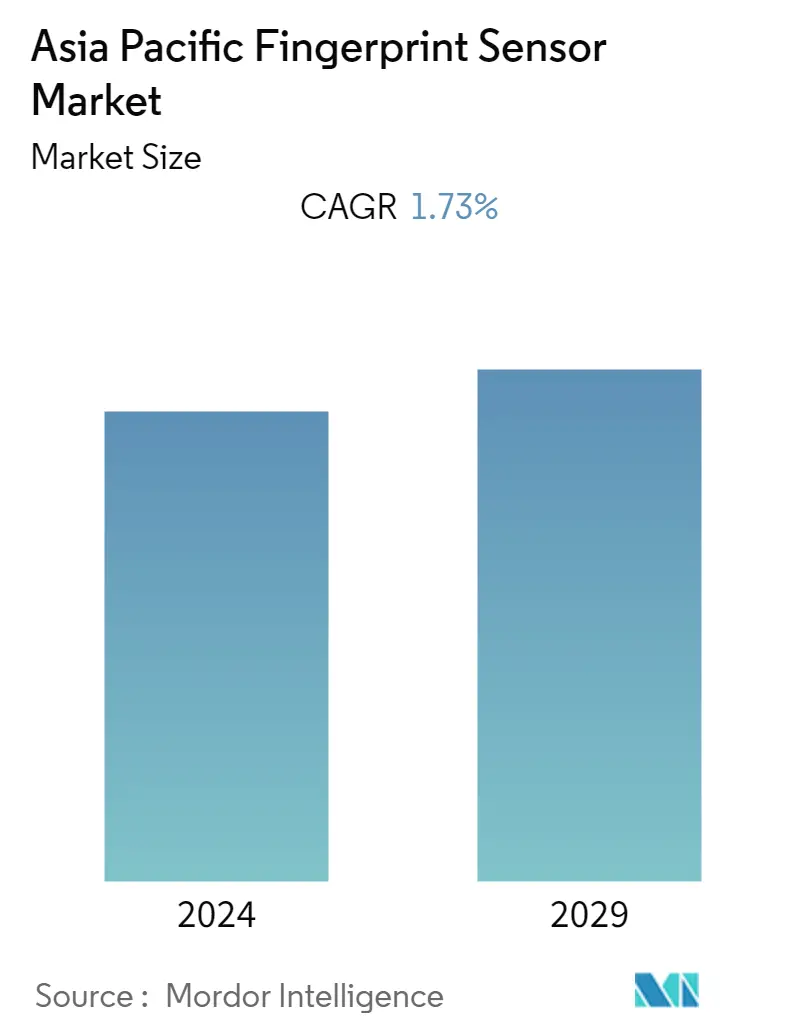Market Size of Asia Pacific Fingerprint Sensor Industry

| Study Period | 2019 - 2029 |
| Base Year For Estimation | 2023 |
| Forecast Data Period | 2024 - 2029 |
| Historical Data Period | 2019 - 2022 |
| CAGR | 1.73 % |
| Market Concentration | Medium |
Major Players
*Disclaimer: Major Players sorted in no particular order |
Asia Pacific Fingerprint Sensor Market Analysis
The Asia Pacific fingerprint sensor market is expected to register a CAGR of 1.73% during the forecast period (2020 - 2025). Increasing mobile transactions in region, coupled with the government's initiatives, are expected to be the major drivers for the fingerprint sensors market in the country. China is witnessing a high mobile transactional volume, which is expected to create potential for the market studied.
- The robust consumer electronics manufacturing ecosystem in China is another important factor fueling the market growth. According to the European Council, China accounts for over 38% of the global consumer electronics market. Major smartphone companies, including Huawei, Apple, Samsung, Xiaomi, and Lenovo, have their manufacturing facilities in the country. With the continuous increase in smartphone sales, the demand for fingerprint sensors that are embedded in smartphones is expected to increase in the region.
- In Asia, China and India have built the world's largest biometric database with initiatives, such as Aadhar and Social Credit Systems. Aadhar is a 12-digit unique number based on the citizen's photograph, iris scans, and ten fingerprints, and as of January 2020, 1,250,784,712 have an Aadhaar number covering 99% of the country's population.
- With the advancements in the field of biometric technology, the region is embracing this technology for authentication. For instance, as per the HSBC's Trust in Technology report, India leads among all other countries surveyed (11 countries surveyed) in the adoption of biometric technology. On average, people in India (9%) are three times more likely than other countries (3%) surveyed to have utilized iris recognition for identifying themselves. Overall, it is about time to see if the advanced biometric technologies like iris would take over the share of fingerprint in the region.
- The Japanese companies in the automotive sector are also actively looking forward to integrating fingerprint sensors in their upcoming models. For instance, Nissan introduced its concept car Nissan Xmotion featured with fingerprint biometric authentication for enhanced security of the vehicles.
- Some of the noticeable companies in the region are entering into strategic partnerships that allow them to further develop the technology, thereby, fueling the demand for the technology over the forecast period. For instance, a new joint venture company has been formed to develop and market next generation biometric applications, through a partnership between Datasonic and South Korea-based Digent.
- With the recent outbreak of COVID 19, the fingerprint sensor market is witnessing a decline in growth due to various organizations and government authorities restricting the usage of biometric systems in their respective premises. For instance, in February 2020, South Korea banned the usage of fingerprint scanners across all government and private organizations owing to the COVID virus that is spread through touchpoints.
Asia Pacific Fingerprint Sensor Industry Segmentation
Fingerprint sensors enable devices to identify and authenticate the fingerprint of an individual for either granting or denying access to services, applications, devices, and physical facility. The scope is comprehensive and is limited to Asia-Pacific.
| Type | |
| Optical | |
| Capacitive | |
| Thermal | |
| Ultrasonic |
| Application | |
| Smartphones/Tablets | |
| Laptops | |
| Smartcards | |
| IoT and Other Applications |
| End-user Industry | |
| Military and Defense | |
| Consumer Electronics | |
| BFSI | |
| Government | |
| Other End-user Industries |
| Country | |
| China | |
| Japan | |
| India | |
| South Korea | |
| Rest of Asia Pacific |
Asia Pacific Fingerprint Sensor Market Size Summary
The Asia Pacific fingerprint sensor market is poised for growth, driven by the increasing adoption of biometric technology across various sectors. The region's robust consumer electronics manufacturing ecosystem, particularly in China, plays a significant role in this expansion. Major smartphone manufacturers like Huawei, Apple, Samsung, Xiaomi, and Lenovo have established production facilities in China, contributing to the rising demand for fingerprint sensors embedded in smartphones. Additionally, initiatives such as Aadhar in India and Social Credit Systems in China have created extensive biometric databases, further propelling the market. The integration of fingerprint sensors in consumer electronics, including smartphones, tablets, and laptops, is becoming mainstream, with companies like Xiaomi, Oppo, and Samsung leading the charge. Despite the challenges posed by the COVID-19 pandemic, which temporarily hindered the use of biometric systems, the market is expected to recover and continue its upward trajectory.
The market landscape is characterized by strategic partnerships and technological advancements, with companies like Datasonic and Digent collaborating to develop next-generation biometric applications. The introduction of in-display fingerprint sensors has enhanced the user experience, particularly in smartphones with OLED displays. India is witnessing significant investments in electronics manufacturing, supported by government policies aimed at boosting the industry. The adoption of fingerprint sensors in banking and financial services, as seen with the State Bank of India's multi-mode biometric authentication, is expected to further drive market growth. The Asia Pacific fingerprint sensor market remains moderately fragmented, with both regional and global players engaging in product development and strategic activities such as mergers and acquisitions. Key developments, such as Qualcomm's 3D Sonic Max and Shenzhen Goodix's ultra-thin optical in-display sensor, highlight the ongoing innovation in the sector.
Asia Pacific Fingerprint Sensor Market Size - Table of Contents
-
1. MARKET DYNAMICS
-
1.1 Market Overview
-
1.2 Industry Attractiveness - Porter's Five Forces Analysis
-
1.2.1 Bargaining Power of Suppliers
-
1.2.2 Bargaining Power of Buyers
-
1.2.3 Threat of New Entrants
-
1.2.4 Threat of Substitutes
-
1.2.5 Intensity of Competitive Rivalry
-
-
1.3 Industry Value Chain Analysis
-
1.4 Assessment of Impact of COVID-19 on the Industry
-
1.5 Market Drivers
-
1.5.1 Increasing Usage of Fingerprint Sensors for Smart Wearable Devices and Smartphones
-
-
1.6 Market Restraints
-
1.6.1 Increase in Adoption of Substitute Technologies, Such as Face and Iris Scanning
-
-
-
2. MARKET SEGMENTATION
-
2.1 Type
-
2.1.1 Optical
-
2.1.2 Capacitive
-
2.1.3 Thermal
-
2.1.4 Ultrasonic
-
-
2.2 Application
-
2.2.1 Smartphones/Tablets
-
2.2.2 Laptops
-
2.2.3 Smartcards
-
2.2.4 IoT and Other Applications
-
-
2.3 End-user Industry
-
2.3.1 Military and Defense
-
2.3.2 Consumer Electronics
-
2.3.3 BFSI
-
2.3.4 Government
-
2.3.5 Other End-user Industries
-
-
2.4 Country
-
2.4.1 China
-
2.4.2 Japan
-
2.4.3 India
-
2.4.4 South Korea
-
2.4.5 Rest of Asia Pacific
-
-
Asia Pacific Fingerprint Sensor Market Size FAQs
What is the current Asia Pacific Fingerprint Sensor Market size?
The Asia Pacific Fingerprint Sensor Market is projected to register a CAGR of 1.73% during the forecast period (2024-2029)
Who are the key players in Asia Pacific Fingerprint Sensor Market?
Qualcomm Technologies Inc., TDK Corporation, Egis Technology Inc., Shenzhen Goodix Technology Co. Ltd and Gemalto NV are the major companies operating in the Asia Pacific Fingerprint Sensor Market.

